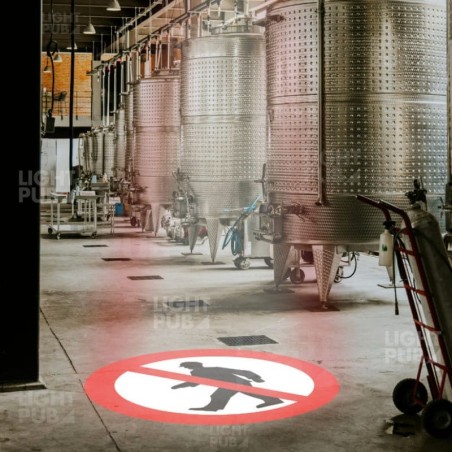Illuminated sign prohibiting pedestrians
The use of an illuminated floor sign, such as a "no pedestrians" symbol, offers a number of advantages when it comes to preventing accidents in a factory. Here's an analysis of the mechanisms and advantages of this technology:
1. Clear, immediate communication
- Enhanced visibility: An illuminated floor sign is often more visible than simple static signage, especially in noisy or congested environments.
- Increased attention: Light attracts the eye, enabling you to quickly capture the attention of workers or visitors, even in situations where vigilance could be reduced.
- Intuitive reading: Projected symbols (signs, arrows, prohibition zones) are immediately understandable, even for people who don't speak the local language.
2. Dynamic delimitation of danger zones
- Flexibility: The projection can be adjusted according to need, for example by moving prohibition zones according to ongoing activities.
- Adaptability: It can indicate temporary changes, such as a no-go zone during maintenance or the relocation of a machine.
- Reinforcement of existing markings: These projections complement or replace traditional floor markings, which are often faded or difficult to distinguish in an industrial environment.
3. Active accident prevention
- Collision reduction:
- Prohibited areas are clearly marked, limiting the risk of interference between pedestrians and moving machinery (forklifts, autonomous robots, etc.).
- Better flow management: Light can guide pedestrians to safe areas or authorized passages.
- Response to environmental conditions: Unlike fixed signs, a light projection remains visible even in poor lighting or partial obstacles.
4. Specific advantages of light in hazard prevention
- Adaptable signage: Colors and light patterns can be modified to convey different information (danger, prohibition, instructions to follow).
- Non-contact technology: Unlike physical barriers, light projections do not impede the movement of machines or people, which is particularly useful in narrow spaces.
- Durability: Unlike physical markings, projections do not wear out, which reduces long-term maintenance costs.
Application examples
In a factory with frequent forklift traffic, a "no pedestrian zone" light projection in front of an intersection can prevent pedestrians from crossing at the wrong moment. This reduces the risk of collision thanks to immediate and effective visual communication.
In short, light plays a key role in preventing industrial hazards, thanks to its ability to attract attention, adapt to environments and reinforce traditional signage.




 Responsive customer service
Responsive customer service
 Fast delivery
Fast delivery
 International shipping
International shipping